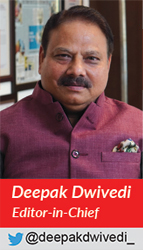 IN 2014, when Prime Minister Narendra Modi began his first term, he inherited a GDP of $2.04 trillion. For the fiscal year 2023-24, India’s nominal GDP was estimated to be nearly $4 trillion. The momentum of past reforms will continue to power India’s growth during PM Modi’s third term.
IN 2014, when Prime Minister Narendra Modi began his first term, he inherited a GDP of $2.04 trillion. For the fiscal year 2023-24, India’s nominal GDP was estimated to be nearly $4 trillion. The momentum of past reforms will continue to power India’s growth during PM Modi’s third term.
A number of these reforms were structural in nature, impacting the economy through institutions and easing the regulatory framework for doing business. To accelerate the pace, the Modi Government will need to push harder politically, dive deeper economically, and deliver more administratively. The imperative is to drive an economic consensus in two areas – first, with political allies and secondly, with state governments.
In his first two terms, PM Modi showed will to pursue reforms in order to serve the country’s development goals. In his third term, he will need to muster the third component of India’s reforms trinity. Following a dexterous stance to push reforms that flowed from the constraints of 1991 and the convictions of 2014-24, he will have to work on building consensus between 2024 and 2029. Being dependent on NDA partners, notably Telugu Desam Party and Janata Dal (United), the Modi Government’s reforms will have to be powered and tempered by political persuasions.
This calls for maintaining policy continuity alongside political dynamism. Between 2014 and 2024, the Government rejected so-called ‘povertarian’ policies and continued with welfare economics, though not at the cost of wealth creation. The Modi 3.0 must continue on this path with greater conviction and draw lessons from the experiences of countries that have adopted socialist policies that failed to bring growth to their economies and prosperity to their people.
From Argentina to Venezuela, and North Korea to pre-1991 India, these countries witnessed shortages, poverty, and a deep suspicion of private enterprise. Policy tools such as taxation and investments, combined with efficient public expenditure and job creation, are the way forward.
The Modi Government must ensure that the reforms delivered by it trickle down to the states with equal conviction. The alpha of India’s combined growth will come from a number of more progressive states. If India is to be a $10-trillion economy by 2032, it will require a nudge for a national alignment and a push for higher growth in states. A consensus around economic growth can also create competitive federalism among other states. Reforms such as those around land, labour and agriculture, need political and administrative support of state governments for implementation.
As PM Modi underlined at the beginning of his third term, despite the political differences India’s rich and deep democracy throws up, economic unity is an essential component of Viksit Bharat. As a corollary, the success of these policies is crucial to prevent a return to the past. A dynamic country like the 21st-century India will need to scrape the rust of the past. It must not encourage political, ideological or cultural inertia to get in the way of growth. The success of the alternative model of growth could bring a political consensus around the direction of a ‘Vibrant India 2047’. The need to create an economic consensus amid political divergences is the biggest challenge to reforms in the next five years, and PM Modi has shown that he is capable of handling such challenges.














